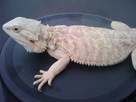Chinese Water Small Dragon - Physignathus cocincinus - Green Water Dragon - Asian Water Dragon

Males reach an adult length (including the tail) of about 3 feet, while females are smaller (aroung 2 feet). A large portion of the overal length is made up of the tail.
Appearance:
Chinese Water Dragons are green, ranging from a dark to quite light green. Vertical slanted stripes of green or turquoise are found on the body. Their bellies are white or pale yellow, and their throats can be quite colorful (yellow, orange, peach). The long tail is narrow and banded with green and brown (and it is also a powerful weapon!). Adult males have larger heads than females, and develop larger crests on the back of the head and neck.
Housing - Tank:
Water dragons need large enclosures - a minimum size for adult dragon is 6 feet long, 2-3 feet deep, and 5-6 feet tall. An enclosure of this size will likely need to be custom made and is going to be costly. Unless you know your dragons are accurately sexed, you may be better of with just one - a male and female pair will likely get along, two males and even two females may display aggression unless given lots of space in a very large enclosure.
Furnishing the Enclosure:
For subtrate, choose something that won't cause impactions if ingested. Sterilized potting soil (no vermiculite or chemicals) with a cover of sphagnum moss can be used (good for humidity), as can a mix of peat, soil and sand, soil and cypress mulch, Astroturf, or paper. Plenty of branches should be provided for climbing and basking (place some diagonally and some horizontally for basking). Live plants such as pothos, dracena, hibiscus, ficus, and staghorn ferns make a good addition.
Water and Humidity:
Chinese water dragons need a good pool of water. It should be large and deep enough so that a dragon can submerge at least 1/2 its height. A kitty litter box works nicely. You need to be able to remove and clean/disinfect the water tub daily, especially if your dragon uses it for a toilet. Thehumidity should be kept at around 80 percent. Mist the enclosure once or twice daily as needed. Potted live plants can help keep humidity up.
Heat and Lighting:
Daytime temperatures should be in the range of 84-88 F (29-31 C), with a basking spot of up to 90 F (32 C). At night, the temperature can be dropped to 75-80 F (24-27 C). There should be a temperature gradient (be sure to measuer temperatures on both the cool and warm sides). A combination of basking light, ceramic heat element, undertank heat pads and heat tape can be used. A UVA/UVB fluorescent fixture should be used (12 hour on, 12 hours off for a day/night cycle).
Feeding:
You can feed crickets, mealworms, waxworms, earthworms, grasshoppers, butterworms, locusts, and possible small feeder fish. Adults can also be fed pinkie mice and kingworms. All insect prey should be gut loaded. wild caught insects are best avoided due to the risk of containing pesticides, and always avoid fireflies as they are ptentially toxic. A small amount (10-15 percent of the diet) of finely chopeed vegetables and fruit can also be offered. Try collards, dandelion, and mustard greens, sweet potato, parsnips, green beans, carrots, and yellow or orange squash. Fruits should be used in smaller quantities than vegetables; try strawberries, raspberries, mangos, papaya, figs, and cantaloupe.
Hatchlings and juveniles should be fed daily, while as a general rule adults can be fed every 2 or 3 days. The best way to determine how much to feed is to look at body condition: skinny dragons need more to eat, and chubby dragons need to be fed less.

Bearded Citrus Babies Dragon - Pogona vitticeps - Citrus Phase Bearded Dragons
Freshmarine: $90.50
You Save 17.72%
Bearded Hypo Babies Dragon - Pogona vitticeps - Hypo Phase Bearded Dragons
Freshmarine: $90.50
You Save 17.72%
Before Placing Your Order
Store InformationShipping Info
Payment Info
Return Policy
Arrive Alive Guarantee
Adoptation Policy
After Placing Your Order
Track Your OrderSecurity Safe Shopping
Compatibility Chart
Shoppers Review









